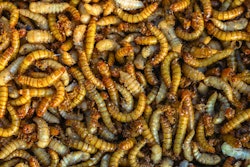
Research institutes and other bodies in the Netherlands are working together to safely process residual animal byproducts into high-quality, protein-rich feeds.
Several companies from the Netherlands are set to work with governmental and non-governmental organizations to examine ways to improve the sustainability of food production. This development is taking place as European Union (EU) member states review the use of processed animal proteins (PAPs) in livestock feeds.
Among the new group’s priorities is the processing of residual animal byproducts for livestock feeds, according to the European Fat Processors and Renderers Association (EFPRA). Underpinning this research are the interdependent goals of making better use of food wastes, reducing carbon footprint, and creating a circular economy. It is hoped these goals will combine to reduce the region’s dependence on imported raw materials and conserve its biodiversity.
For the newly created knowledge center, the key target is to provide an additional 1 million metric tons into the food chain each year. Using the Fieldlab principle — approaching the circular economy from the business perspective — the team aims to develop business models for a range of circular products to be delivered through retailers and food service outlets.
This latest collaboration fits well with the European Green Deal and the EU’s Farm to Fork strategy, according to Carine van Vuure. She is manager of nutrition and regulatory affairs with Darling Ingredients, one of the research group partners.
“Naturally, the participants within the circular food chain can immediately start with animal products that are already fully permitted under existing legislation,” she said. “Animal fats, plasma powder and hemoglobin are a few examples.
“Through the Fieldlab, chain partners can prepare themselves for the use of PAPs in the long term if legislation is amended at EU level. This is expected to be possible in the course of this year. If these conditions are met, the products can contribute to a sustainable circular economy,” she said.
Additional hoped-for benefits are improved farm animal health and welfare, according to van Vuure.
Europe reviews lifting some restrictions on use of PAPs in animal feeds
According to EFPRA, PAPs are nutritionally rich feed ingredients that help produce healthy animals. PAPs manufactured in Europe are made from animal byproducts that are fit for human consumption. As well as being safe, they are sustainable because they prevent valuable food going to waste.
In December 2020, the possibility emerged of some lifting of the regulations of the use of PAPs in animal feeds with respect to the risks of transmissible spongiform encephalopathies, of which bovine spongiform encephalopathy (BSE) is an example.
At the time, the European Commission presented three proposals to the Standing Committee on Plants, Animals, Food and Feed (SCoPAFF). These open up the possibility that poultry diets could in future include PAPs from pigs and farmed insects. Furthermore, PAPs from poultry and insects could be used as ingredients in feeds for pigs. Also proposed was inclusion of ruminant collagen and gelatin in diets for non-ruminants.
According to the U.S. Department of Agriculture (USDA) Foreign Agricultural Service, these proposals are likely to be approved at a forthcoming SCoPAFF meeting this month or in May. With some reservations, member states generally support this step-wise lifting of the restrictions.
If approved, the changes will need to be passed by the European Parliament. As they are widely supported by the member states, the Parliament is unlikely to block the proposals.
European feed manufacturers support wider use of PAPs
In the EU, several feed ingredients are prohibited due to potential health risks that are considered “unmanageable.” These include certain PAPs, which were banned from inclusion in feeds in 2001 after the BSE crisis.
European feed manufacturers’ association FEFAC supports the gradual lifting of the bans, based on a positive risk assessment from the European Feed Safety Authority (EFSA).
Since 2013, PAPs from pigs and poultry have been authorized for inclusion in fish feeds in the EU.
According to FEFAC, the re-authorization of pig PAPs in poultry feed and vice-versa is included in the policy initiative, the EU Farm to Fork strategy.
Based on experience with the use of PAPs in aquaculture feeds, FEFAC highlights three aspects that are key for any future use of PAPs in EU animals feeds.
Firstly, FEFAC says, the practice must be accepted by downstream partners, including livestock farmers and consumers. Also crucial is a legal framework for specialized production lines. This will ensure that, for example, feed companies using PAPs from pigs for poultry feed should not also be used for the production of pig or ruminant diets. Finally, FEFAC highlights the need for effective analytical tools to identify the presence of prohibited PAPs.
Introduced in 2002 and still prohibited in the EU for use in feed for food-producing farm animals and fish are PAPs from ruminants and catering waste. The latter — swill feeding — is thought to be a significant risk factor for the transmission of African swine fever and classical swine fever.














